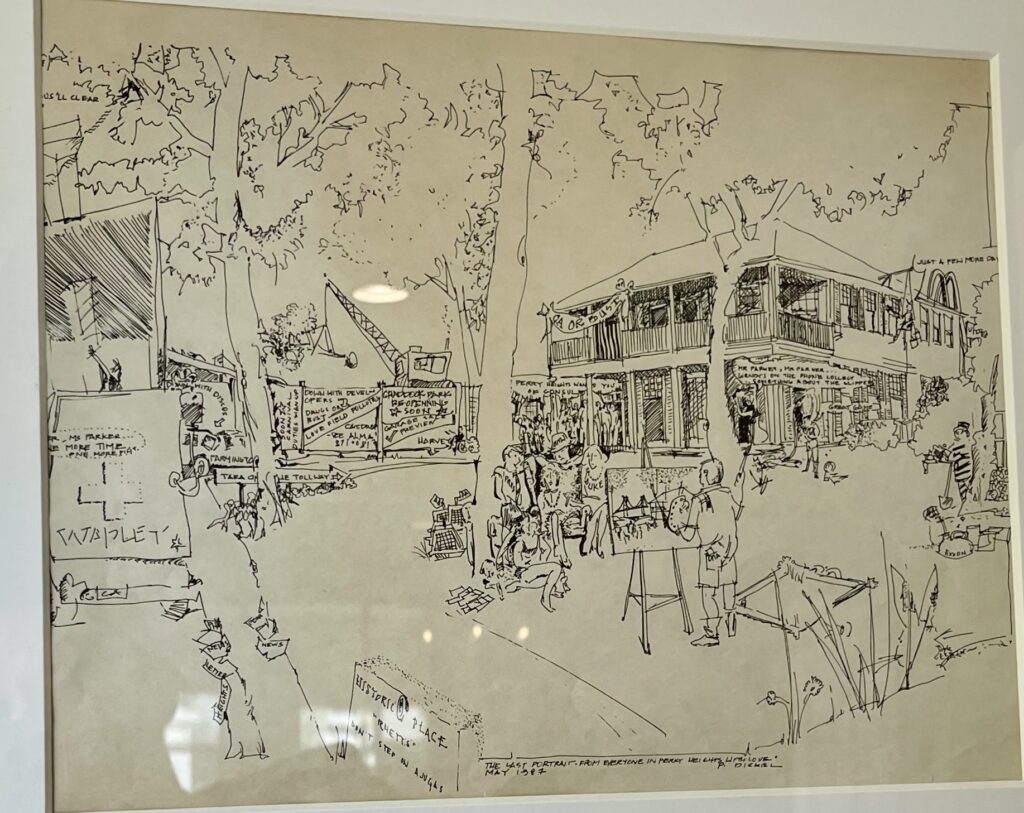
Over the years, the lush, peaceful Perry Heights neighborhood we see today has seen plenty of challenges. As the neighborhood turns 100, it’s good to look back at some of the challenges our neighborhood has faced over the years.
From the beginning of our neighborhood in the Roaring ’20s to today, we are celebrating what our founder, Gordon Perry, dreamed of: a well-built, brick neighborhood that attracts people from every stage of life and various economic backgrounds into a true urban dream neighborhood where we can enjoy attractive tree-lined streets, gardens, and friendly neighbors. Without air conditioning, the original homes had sleeping porches to use in the summer to catch a breeze. This was the inspiration for the Perry Heights advertising slogan, “Cool at Nights.”
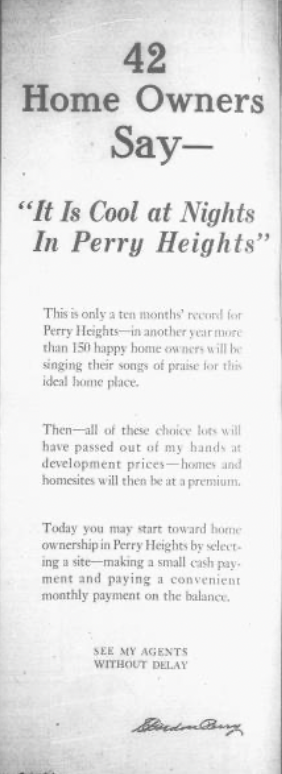
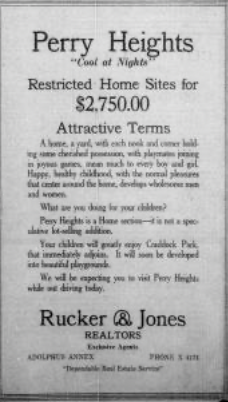
The ’40s, ’50s, and ’60s were a time of togetherness and community, with neighbors giving each other wedding showers, holding weddings in their homes, sending men to fight in WWII, and caring for war widows. After the war, a surge of children in the neighborhood would constantly be playing in front yards and in the park. But as we know, every neighborhood has cycles.
The late ’60s and ’70s were a difficult period for Perry Heights and the Oak Lawn neighborhood. As in the rest of the country, white flight and panic over integrated schools drove families into the nearby suburbs. Areas in and around Oak Lawn became less desirable. Many of the homes in the neighborhood turned into rentals and their tidy appearance began to suffer. Counterculture types such as hippies and artists, attracted to the low rents, began to move into the area. The decline in value also attracted developers who wanted to buy up lots, demolish homes, and build more dense apartment buildings. About this time developers purchased the old Perry Estate and eventually tore it down and built Park Place condominiums in 1968. Developers demolished most of the homes around Perry Heights along Lemmon and Cedar Springs by the mid-1970s and built apartment buildings, retail strip centers, and fast food businesses. The Wycliff-Douglas couplet that was created to connect the Dallas North Tollway to U.S. 75 (Central Expressway) had already claimed 30 homes in Oak Lawn that had to be demolished for the project. The increase in density also brought crime, traffic, homelessness, and prostitution into the neighborhood streets.
In the 1970s, the neighborhood faced a new challenge. An absentee owner had inherited his parent’s home in the 4400 block of Vandelia. He was offered significant rental income to turn the home into a group home or halfway house. Because our neighborhood is zoned for single-family use, the neighbors hired an attorney and fought successfully to keep this type of housing category out of the neighborhood.
It was around this time that a group of Perry Heights neighbors also realized that they needed to do something to protect what was left of Perry Heights and preserve the peaceful, quiet community they knew. They banded together and, in a two-year struggle, were able to convince the city to close off vehicular traffic with curbed diverters at three intersections: Herschel and Lemmon, Herschel and Cedar Springs, and Prescott and Lemmon. Not everyone in Perry Heights was in favor of the closures, but 90% were, according to the petition. The closures reduced cross-traffic by an estimated 6,000-8,000 cars per day and helped unite the neighborhood. A block party with entertainment by the Paul Guerro Orchestra celebrated the achievement. Thus, 1974 saw the beginnings of what would become the Perry Heights Neighborhood Association.
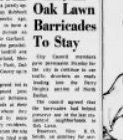
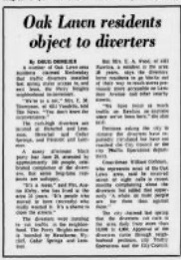
Neighbors had other concerns including the noise from Love Field airport. Oak Lawn Residents began what was called the Oak Lawn Preservation Society in 1973 to fight some of these local problems. The founder and many of the members were also Perry Heights residents.
In 1985, the neighborhood thwarted an attempt by a developer to take additional land from Craddock Park to create a northbound entrance to the Dallas North Tollway and build a large-scale rental development between Lemmon and Cedar Springs. The Springs project was defeated by the neighborhood opposition. The Springs was developed, but in a much more pared-down form and without the tollway entrance ramp or the retail plan.
In 1985, the neighborhood formed the Perry Heights Neighborhood Association (PHNA) making everyone who owns a home in Perry Heights an automatic member of the association.
By 1991, absentee apartment building owners and the real estate crash left buildings and construction projects surrounding Perry Heights abandoned. This created more serious urban problems such as drug houses, prostitution, and increased homelessness. The city didn’t have the money to raze the two dozen buildings on 17 acres beginning with 4500 Cedar Springs Road that, according to news articles, was referred to as Beruit, because the area looked like the bombed-out remnants of war. It would take another decade for the area to be rebuilt.
It was during this time that PHNA began working with the city and had fundraisers such as neighborhood sales and other events to build the walls at the blocked intersections. The intent was to stop the flow of pedestrians from Cedar Springs and Lemmon by way of Prescott and Herschel. This goal was finally achieved in 1995 when the city conditionally deeded the dead-end streets to the Association. The conditions include keeping the Association active, maintaining the walls and streets, paying property taxes, and carrying liability insurance. Much appreciation goes to David Wagner and John Mahoney for making certain many of these conditions have continued through the years with the voluntary contributions from the neighborhood residents.

By the 1990’s, Oak Lawn had become a destination for the GLBTQ population in Dallas. Many whom had been renters were now purchasing homes in Perry Heights and renovating them. This new gay wave in the area was not without some controversy. So many gays and lesbians were moving to Perry Heights that it was often referred to as Fairy Heights.
With the increase in renovations in the neighborhood, some residents began pushing for a Conservation District to preserve the look and feel of the neighborhood. Although noble in theory, some homeowners did not want a committee restricting what they could build or how their homes should look. The Association experienced its first “civil war.” Ironically, the same owner that wanted the group home on Vandelia, demolished that house and began building a house that many felt did not share the same character of the neighborhood. During the quarrels and calls for code enforcement, a group of Rawlins residents splintered off and established a Rawlins-only Conservation District in 2007. This left some neighbors feeling abandoned and bitter.
There was a call for significant change to the PHNA bylaws at that time. The change in articles of the Association’s updated bylaws was to be more equal in the representation of the entire neighborhood and more transparent and inclusive. Current resident, Howard Weinberger, along with David Ellis, Weston Woods, and Mike Sawicki were the architects of the updated bylaws. Since the unification of our Board, the Association has successfully worked with the developer of a townhouse project at the edge of Perry Heights at Wycliff and Vandelia and the apartment building on Wycliff and Cedar Springs to alter the plans to be less impactful to our neighborhood. Many Perry Heights residents are also members of the Oak Lawn Committee, which is designed to protect the Planned Development District 193 district (est 1985) and work with developers requesting variances on projects in Oak Lawn. This district stretching from downtown to Inwood has different zoning and building restrictions than other districts within Dallas. The neighborhood around us has become more gentrified and this has lulled many in the neighborhood into a false sense of security and, unfortunately, apathy. This is troubling as there is a significant uptick in development in the last few years.
We have recently elected a new Perry Heights Neighborhood Association board. They will serve an important role in protecting and preserving Perry Heights for generations to come.
While it’s impossible to note every neighbor who fought to protect Perry Heights over the decades, there are numerous past neighbors whose names, initiative, and leadership should not be forgotten:
Celeste and Paul Guerro, Ann & Bill Gilliland, Brian Hayes, Plato and Dorothy Karayanis, Cay and Key Kolb, Howard Okon, Harry S. Parker, Patsy and Arch Swank, Patricia Evans, and Stephen Rosenthal .
There are also many neighbors that are still in Perry Heights and continue to fight for our neighborhood.
We owe each of them our thanks and our appreciation for being active and taking their time, concern, and resources to preserve our unique neighborhood.

What a great story of the good life, the hard life and the struggles Perry Heights has gone through. Thank you for posting this extensive history and now it is time for you to celebrate!